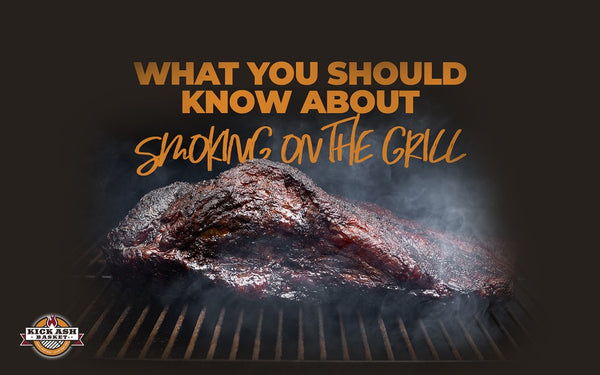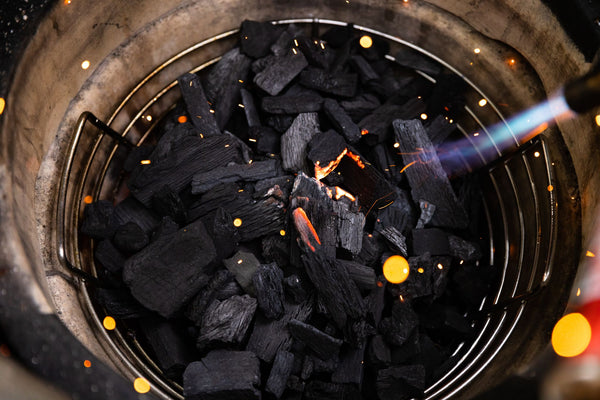
What You Should Know About Smoking on the Grill
There are two thoughts that often come to mind when you think of smoked meat: that irresistibly rich and mouth-wateringly delicious flavor… and “wow, that sounds like a lot of work.” But smoking meat on a charcoal grill isn’t as hard as it seems. You can get that scrumptious taste for your meats right at home without the hassle. In this article, we’ll go through everything you need to know about smoking, the best smoker grills, and how you can get started smoking your own meat at home.
What is Smoking?
Smoking can refer to two processes: 1) preserving meat through a long exposure to heat and smoke (dehydrating it and removing any bacteria) and 2) barbecuing it in the most scrumptious way possible (yeah, we’re pretty sure that’s the dictionary definition).
Today’s smoking tends to refer to the second definition, as the first is the “classic” way of smoking used for preserving meats. Our “smoking” BBQ refers to the process of cooking meat slowly on indirect heat over a long period of time (about 12-16 hours or more). This process creates a tender, juicy bite while adding the smoky flavor we associate with outdoor grilled meat. I don’t know about you, but smoking reminds me of our good ol’ caveman days when meat was cooked over an open fire. It just feels like the way meat is supposed to be cooked.


Photo by Christian Wiediger on Unsplash
Smoking Versus Grilling
Although you can smoke on a grill, smoking and grilling are different processes. Grilling is when you throw something on your charcoal or gas grill and you cook it on a high temperature for a shorter period of time. Smoking is the “traditional” form of barbequing, and it’s when you cook low and slow over indirect heat for several hours.
Some people confuse smoking and braising. Braising doesn’t occur on a grill, though. Braising is when a piece of meat is browned in fat or oil and simmered over low heat in a liquid, often over the stovetop. This creates a similar sort of tender, succulent meat, but it won’t result in a smoky flavor and crisp crust (Psst… that crisp crust is called “the bark!”).
What are the benefits of smoking?
-
Smoky flavor without getting burnt (that “smoky” flavor comes from the compounds syringol and guaiacol, which occur by limiting the oxygen during the cooking process).
-
Tangy crust (bark) on the skin of the meat (arguably the best part, right?).
-
Soft, tender piece of meat that holds all its juice.
-
Easier to cook delicate meats without drying them out.
-
Low-and-slow cooking may be better for your health (lots of “burn” marks from faster cooking processes may create oxidants in your body).
What is a smoker grill?
It’s pretty hard to “smoke” over a gas or electric grill, because you’re not really getting any smoke coming off the gas. You’ll want to cook over charcoal or wood pellets to get that natural fire and the associated smoke that comes with it. Charcoal and wood are “flavored” heat sources, meaning the cooking process actually adds its own flavor to the meat. Gas and electric grills aren’t flavored, so you have to rely on the seasoning and sauces to add flavor— which doesn’t really work for a true smoking process.
One of our favorite smoker grills is the Kamado Joe Classic or the Big Green Egg (large). These charcoal grills are designed for barbequing smoky, delicious meat. Even though wood is the original smoking method, we prefer charcoal over wood for a few reasons:
-
Wood burns very quickly, so you’ll need to stoke the fire and add more wood every 30 to 45 minutes. This means you have to hang out by your grill for hours on end. We’d rather spend that time with friends and family.
-
Charcoal is wood that has already been burned, so it burns slower and cleaner. It will burn longer and more-evenly, so it requires less hands-on care than wood.
-
Charcoal is easier to light and start than wood. With the right charcoal prep gloves and even a grill torch lighter, you can safely and easily light charcoal in a snap.
-
The flavor of charcoal is deeper and richer than what you get with wood. It naturally creates that smoky flavor, so you’ll tend to get a more-intense flavor with charcoal (some people prefer the wood flavor, so go with what you like the most!).
-
Charcoal grills like the Kamado Joe and BGE are made with ceramic. Ceramic retains heat better than metal wood grills, so more of the heat and smoke stays inside to cook the meat.
-
Charcoal grills just require a two-zone cook, whereas wood cooking requires chips, soaking, proper placement, and other details to make sure the final product comes out right. Charcoal is overall easier to use for a lot of people.
We love this blog about how a Kamado grill made Paul switch from gas to charcoal to get that rich, smoky flavor we all crave.
Did you know you can learn more about the Big Green Egg at Eggtoberfest?
Along with charcoal grills, there are smoker grills designed specifically for preparing smoked foods. However, unless you’re going to only be smoking food every time you fire up the grill, we recommend a charcoal or wood pellet grill so you have more variety of cooks. Charcoal and wood add just enough smoky flavor, while also usable for other direct-heat cooking methods if you’d like.

How to Smoke Meat
1. Choose the right meat.
The quality of the smoke starts with the quality of the meat you choose. Here are some points to keep in mind when selecting your meat for smoking:
-
Fat, tough cuts of meat like the shoulders, ribs, and muscles work best for smoking. These cuts have connective tissues and collagens that break down slower during the smoking process, which results in a tender and juicy bite. Bonus is that these cuts of meat tend to be cheaper and work great for budget-friendly meals.
-
Find quality-sourced meat. Make sure you get your meat from a butcher, so you’re getting the healthiest and freshest meat. Avoid frozen meat when possible. You’ll already be getting the less expensive cuts, so you want a high quality of meat to get the best flavor.
-
The most popular meats for smoking include: brisket, pork butt/shoulder, and of course ribs.
Aside from meats, you can also smoke other foods. Smoked cheeses are a fan-favorite, and mushrooms and other hearty veggies are undeniably scrumptious when smoked. I personally love smoking tomatoes and chilies to create a homemade salsa that no one can resist.
2. Prep your meat.
Trimming: We recommend removing the excess fat off your meat, especially if you’re new to smoking. The fat cap won’t really impact the cook, but it traps moisture so you might not get as crisp of a bark (crust) on your meat. Try trimming the fat as close as possible so you get a clean crust. Learn how to trim fat off meat here.
Truss Poultry: “Trussing” refers to tying up your meat, so all the extra flabs cook at the same pace as the main portion. This is most important for irregularly-shaped meats, like chicken and turkey. Your butcher may already tie these up for you, so you can leave these cuts in their trusses if you’d like.
Salt: You’ll definitely want to salt your meat to help tenderize it and bring out the natural flavors in the cut. In general, you’ll want about 1/2 teaspoon of kosher salt per pound. You can also dry-brine your meat if you’d like to make it even saltier and more flavorful, but be careful not to leave your meat brining too long or it will start to break down the collagen that’s required for smoking.
Seasoning: Don’t be afraid to add marinades, sauces, and rubs before smoking. They’ll add gorgeous layers of taste that pair nicely with the smoking process. We love using barbeque dry rubs or sticky sauces that pack on the flavor. This is where you have the freedom and creativity to experiment! Try out our Sweet Mama Bold BBQ rub for a scrumptious, easy-to-use rub that will bring out the rich flavor of the meats during the smoking process.
3. Set up a two-zone on your charcoal grill.
For smoking, you’ll use indirect heat for cooking. This means you don’t place the meat on top of the heat source. Instead, you let the smoke hit the meat as it circulates through the grill, creating a more-controlled and lower-temperature cook.
Creating a two-zone setup is easy on a charcoal grill. Put your Kick Ash Basket in your grill. Use the KAB Divider to easily create two zones. Put all the charcoal on one side of the divider opposite of the locking base tab and leave the other side empty. Ignite the charcoal. Place the meat on the grate over the empty side (not above the charcoal). Close the lid, and you’re ready to go!
Note: If you’ll be using a wood grill for smoking, there’s a more in-depth process you’ll need to follow, like selecting and soaking your wood chips. Check out this Masterclass to learn how to smoke with a wood pellet grill for more info.
4. Learn how to use the Maillard Reaction.
The “bark” is that dark, blackened crust outside the smoked meat. It’s one of the best parts of the meat! This comes from the “Maillard Reaction,” which occurs when the compounds in the meat react to heat and create new compounds. Essentially, the proteins and the sugars in the meat blend together, kind of like the process of caramelizing. That’s why that bark tastes so smoky yet sweet at the same time.
To get this scrumptious bark:
-
Make sure you’re using a dry heat (moisture can ruin this process).
-
Trim the fat during prep to help remove extra moisture.
-
Sprinkle a little sugar on top of the meat (often found in dry rubs) to speed up the caramelizing process.
-
Keep it low and slow (cooking too fast with sugar on the meat can burn the crust).
5. Cook low and slow.
Remember that smoking is about cooking low and slow. Smoking temperature is typically between 200-250°F. Smoke time varies based on size of cut, cooking temperature, moisture, and salt. Even the weather can impact it. You’ll want to invest in a quality meat thermometer to make sure your meat is cooked all the way through.
You also want to make sure your meat is fully cooked to burn off any bacteria or pathogens.
To kill bacteria, you want your beef and pork cooked to at least 145°F, with chicken up at 165°F. This temperature can be too high for smoking. Thankfully, they’ve found that bacteria can be killed by applying lower levels of heat for longer periods. For example, beef can be pasteurized (removed of bacteria) at 135°F for 37 minutes.
Don’t be scared off if the inside of your pork or beef looks a little pink. That can be a side effect of smoking that we call the “smoke ring.” As long as your meat has hit an internal temp of 160°F or cooked for several hours, all of the bacteria should be killed off. Check out this guide to safe cooking temperatures.


Photo by Luis Aleman on Unsplash
Cooking Tips for Smoking on the Grill:
-
Do NOT flip your meat. You are using an indirect cook, so your meat should cook evenly.
-
Focus on smoke flow (ventilation). You’ll want to create enough ventilation for the smoke to escape (so you don’t burn the meat), without letting too much oxygen into the smoking process.
-
Keep your lid closed until the meat is ready. You want the smoke to build up without exposing the cook to extra oxygen by lifting the lid.
Example: Smoked Spare Ribs
Smoked spare ribs fall off the bone with a smoky flavor that pairs beautifully with barbeque sauce. Ribs have a lot of connective tissue that softens when smoked, so it creates a tender and juicy bite. They’re smaller, so they don’t require as much time as larger cuts. However, they can be more challenging to learn, and too much time in the smoker grill can lead to burnt and dry ribs.
Check out this recipe for smoking baby back ribs on a charcoal grill.
Get Started with a Smoker Grill
Smoking can feel intimidating at first, but it’s actually an easy way to barbeque your favorite meats. Not only is it budget-friendly, but you’ll also get tender, juicy meat that the whole family will love.
Not sure how to get started smoking or what smoker grill is right for you? No worries. Contact us and we can help! We love smoking, and we want to help you love it as much as we do!


